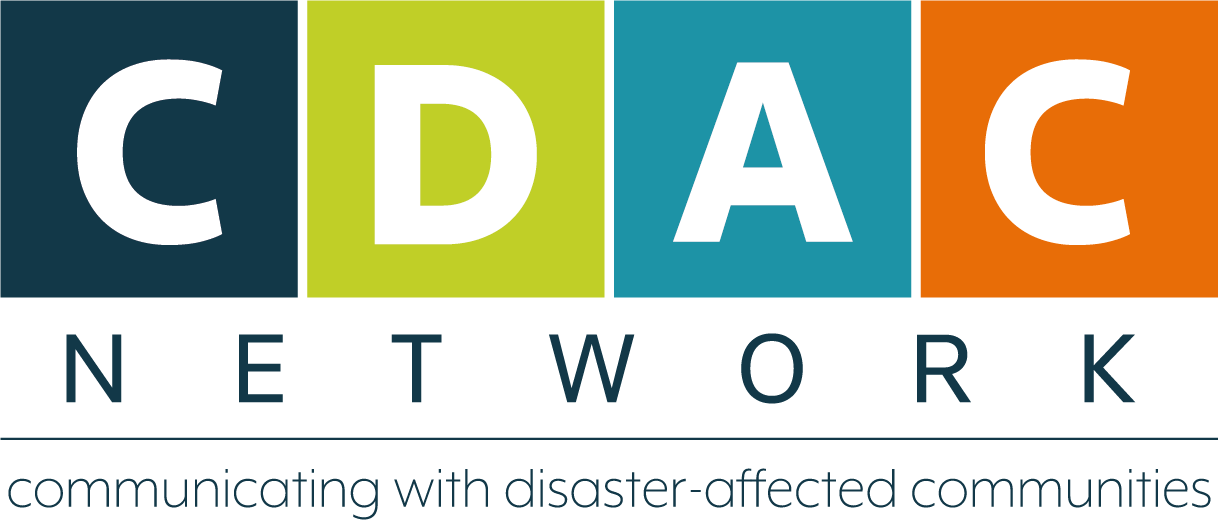Resources
Search our resources
Or filter resources by
Country/region
- Afghanistan 2
- Africa 32
- Americas 3
- Asia 11
- Bangladesh 3
- Belarus 1
- Burkina Faso 3
- Caribbean 7
- Chad 1
- Colombia 3
- Cote D'Ivoire 1
- DRC 1
- Dominica 2
- Ethiopia 3
- Europe 10
- Fiji 6
- Global 52
- Guinea 1
- Haiti 4
- Hati 1
- Horn of Africa 8
- Indonesia 1
- Iraq 1
- Kenya 6
- Libya 1
- Malawi 1
- Middle East 8
- Morocco 2
- Mozambique 4
- Myanmar 1
- Nepal 3
- Niger 2
- Pacific 13
- Pakistan 4
- Palestine 2
- Papua New Guinea 4
- Philippines 6
- Sierra Leone 1
- Somalia 3
- South Sudan 2
- Southeast Asia 7
- Sudan 4
- Syria 3
- Turkiye 3
- Ukraine 6
- Vanuatu 5
- Yemen 1
- Zimbabwe 1
Topic
- AI 3
- CDAC Public Forum 12
- COVID-19 12
- DEPP 7
- Ebola 1
- National Platforms 9
- PSEA 2
- SMS 2
- Sudan 1
- accountability 44
- capacity bridging 15
- cholera 2
- climate 11
- communication 110
- community engagement 80
- conflict 17
- coordination 51
- cyclone 3
- development 1
- digital 30
- disability 2
- disaster 41
- displacement 13
- drought 3
- earthquake 12
- feedback 7
- financing 5
- floods 3
- health 16
- hotline 1
- hurricane 2
- inclusion 11
- information 70
- information integrity 3
- journalism 31
- localisation 28
- media 50
- media development 3
- misinformation 4
- needs assessment 7
- participation 10
- perceptions 1
- policy & advocacy 15
- protection 2
- psychosocial 1
- radio 5
- safeguarding 2
- social media 17
- training 3
- typhoon 5
Assessment of communication, community engagement and accountability in Sudan
CDAC Network (with funding support from UNICEF) conducted an assessment between April and July 2021 on the status of response-wide communication, community engagement and accountability (CCEA) work with affected populations in Sudan. This report is based on consultations with 29 humanitarian and non-humanitarian actors in-country within Sudan
Assessment of communication, community engagement and accountability in Colombia and recommendations for response-wide synergy
This study used qualitative methods to generate an understanding about the systems of beliefs, perspectives, and experiences of a diverse sample of actors, as a basis to support a collective CCEA approach in Colombia.
Information management functions of an inter-agency AAP/CCE working group
Guidance developed for AAP/CCE information management officers.
Situational analysis of communication, community engagement and accountability in Burkina Faso
From the scoping mission of the status of response-wide Communication, Community Engagement and Accountability towards Affected Populations (CCEA) in Burkina Faso
Accidental and intentional innovation: valuing what’s there – Public Forum report
This report summarises the main themes raised during the 2019 CDAC Network Public Forum and offers solutions to some of the innovation challenges facing the humanitarian system.
Accidental and intentional innovation: valuing what’s there
Written in advance of the 2019 CDAC Network Public Forum, this background paper looks at the evolution of innovation in the humanitarian sector.
How-to guide: collective communication and community engagement in humanitarian action
A guide to implementing communication. community engagement and accountability programming in humanitarian action, bringing together a decade of best practice.
‘From words to action’: communication & community engagement in humanitarian action – Africa regional workshop report
Report from the Communication and Community Engagement Initiative (CCEI) workshops in Nairobi.
Advancing a collective model for communication and community engagement: lessons from the Rohingya response
A real-time evaluation of the coordination of communicating with communities (CwC) in the Rohingya refugee response in Cox’s Bazar, Bangladesh since August 2017, focusing on the role and contribution of the CwC Working Group.
Global frameworks and commitments on communication and community engagement
There are a number of global level frameworks and commitments that have components specific to communication and community engagement. While these spell out what action needs to be taken, they are not consistently and coherently taken on board by humanitarian actors. This paper summarises those existing frameworks.
An assessment of surge capacity available for communication and community engagement
An assessment of the level and quality of surge capacity available for communication and community engagement in the humanitarian sector.
The characteristics of different communication channels
A description of different communication channels, their coverage and reach, the type of information that is suitable for dissemination in this way, the level of interactivity with the audience, and the cost. This document is useful in the planning of communication and community engagement activities.
Policy brief: The role of collective platforms to support communication and community engagement in humanitarian action
This independent review commissioned by CDAC Network confirms that the establishment of collective approaches to communication and community engagement – at national and global levels – is required to be more systematic and effective and has significant support across the humanitarian sector.
The role of collective platforms, services and tools to support communication and community engagement in humanitarian action
This independent review confirms that the establishment of collective approaches to communication and community engagement – at national and global levels – is required to be more systematic and effective and has significant support across the humanitarian sector.
Creating an internally displaced persons information centre in Iraq
A case study about the interagency information centre for internally displaced persons that opened in Iraq in July 2015.
In Nepali: information and communication questions for needs assessments
As part of their support to the Nepal earthquake response, Translators without Borders translated 10 key questions on information and communication needs into Nepali.
Fanning the flame: the CDAC Network – a movement for change
This paper charts the story of the CDAC Network from the now infamous ‘pub meeting’ in New York in 2009 to the Network’s first Members’ Council in May 2014. It tells the story of the Network’s formative years: a time of forming and storming as the diverse membership set about building a movement for fundamental change in the way the humanitarian sector operates.
Typhoon Haiyan learning review
This learning review of the humanitarian response to Typhoon Haiyan, which struck the Philippines in November 2013, examines initiatives aimed at improving communication with communities, and the coordination of these initiatives.
Consolidating community feedback through CwC and AAP Technical Working Groups in the Philippines
This case study describes how Communicating with Communities (CwC) and Accountability to Affected Populations (AAP) staff worked together through technical working groups to try and ensure community feedback was acted upon in the response to Typhoon Haiyan in the Philippines.
Communication with communities during the first six weeks of an emergency
What are the minimum deliverables in a humanitarian response to meet a community's information and communication needs? This practice brief has been developed to describe the essential elements required to meet a community's information and communication needs during the first six weeks of a response.




















